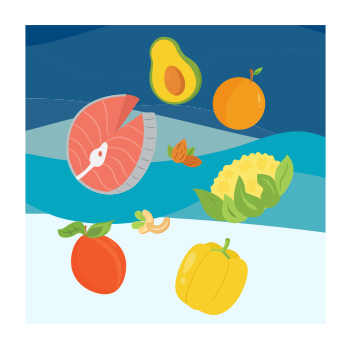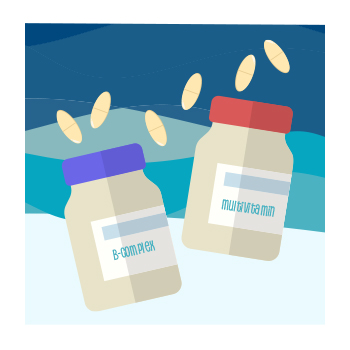


Sign-up for {N}power to get exclusive discounts, newsletters, members-only features, and more!

Full disclosure: I am a mom of a tween girl, so this topic is close to my heart. The research was distressing to read, because frankly, the mental state of tweens and teens in this country is bleak. School shootings, climate anxiety,1 and the pressures of social media, on top of the normal social and academic anxiety that tweens and teens experience is all too much. The statistics speak for themselves: Recently published data from the Centers for Disease Control and Prevention (CDC) found that 22 percent of high school students said they had seriously considered suicide in the past year and 10 percent said they had attempted suicide at least once. All demographic groups across race, ethnicity, and gender experienced increases in suicide risk since the CDC first started collecting this data in 2011, but certain groups faced greater risk than others.
The report shows that nearly 3 in 5 (57%) U.S. teen girls felt persistently sad or hopeless in 2021—double that of boys and a 60 percent increase from 2011. Among teen girls, nearly 1 in 3 (30%) seriously considered attempting suicide—up nearly 60 percent from a decade ago. The report also found more than half (52%) of LGBTQ students had recently experienced poor mental health and more than 1 in 5 (22%) attempted suicide in the past year. African American students were also more likely to attempt suicide than their Asian American, Latino, or white peers while Native American students had the highest rates of “suicidality” (suicidal thoughts, plans, and attempts). Overall, nearly 30 percent reported that their mental health was “most of the time or always not good.”2 3
Our kids are experiencing a mental health crisis. As the adults who love them, it’s critically important that we are aware of what is happening. As much as we’d like to, we can’t change the world, but we can be equipped with the information and tools to help our kids thrive.
 Adolescents are notorious junk food junkies (my daughter has been raised on healthy food, yet, to my dismay, she still loves alllll the junk food; like one parent said, “It must be in their DNA to crave Sour Patch Kids and Takis”). Research confirms what we parents know: Adolescents are among the demographic group that consumes the most ultra-processed foods (UPF) and drinks (e.g., soft drinks, candy, sugary breakfast cereals, packaged baked goods, chips, pizza, fries, etc.) A 2022 study found that participants aged 14-17 reported eating about eight servings of UPF every day, with boys showing a higher consumption than girls, while their consumption of fruits and vegetables were lower than recommended (on average, less than two servings per day). Higher consumption of UPF was associated with a higher presence of depressive symptoms across the board, and behavioral problems like fighting or teasing others, not listening to rules, and not understanding others’ feelings, particularly among males. Female adolescents reported more depressive symptoms, anxiety, and internalizing problems.4 Previous studies corroborate these findings, including one recent study that found adolescents who consumed seven or more soft drinks a week had “significantly higher levels of anxiety and depression.”5 6 7
Adolescents are notorious junk food junkies (my daughter has been raised on healthy food, yet, to my dismay, she still loves alllll the junk food; like one parent said, “It must be in their DNA to crave Sour Patch Kids and Takis”). Research confirms what we parents know: Adolescents are among the demographic group that consumes the most ultra-processed foods (UPF) and drinks (e.g., soft drinks, candy, sugary breakfast cereals, packaged baked goods, chips, pizza, fries, etc.) A 2022 study found that participants aged 14-17 reported eating about eight servings of UPF every day, with boys showing a higher consumption than girls, while their consumption of fruits and vegetables were lower than recommended (on average, less than two servings per day). Higher consumption of UPF was associated with a higher presence of depressive symptoms across the board, and behavioral problems like fighting or teasing others, not listening to rules, and not understanding others’ feelings, particularly among males. Female adolescents reported more depressive symptoms, anxiety, and internalizing problems.4 Previous studies corroborate these findings, including one recent study that found adolescents who consumed seven or more soft drinks a week had “significantly higher levels of anxiety and depression.”5 6 7
On the other hand, a healthy diet (at least a more balanced diet in which healthy foods outnumber junk foods) goes a long way to support mental health and wellbeing. A study published in the journal PLOS ONE examined the diets and mental health of nearly 3,000 adolescents between the ages of 11 and 18 over the course of two years and then again two years later. Even when accounting for socio-economic status, gender, and physical activity, the kids with healthier diets had better mental health. The researchers qualified a healthy diet as two or more servings of fruit per day, four or more servings of veggies per day, and eating food from home versus restaurant/fast food. The researchers also found that when the kids’ diets improved, so did their mental health, while reductions in diet quality were associated with “declining psychological functioning” over the follow up period.8 I know it may be hard (impossible) to completely eliminate junk food from your tween/teen’s diet, but remember—it’s all about balance!
 In a moment of synchronicity, as I was writing this article, the U.S. Surgeon General issued a warning about social media use and young people, saying that “We are in the middle of a national youth mental health crisis, and I am concerned that social media is an important driver of that crisis—one that we must urgently address.” The report stated that “there are ample indicators that social media can have a profound risk of harm to the mental health and well-being of children and adolescents.”9 Research backs this up. A review published in 2020 found evidence from a variety of studies that “…implicate smartphone and social media use in the increase in mental distress, self-injurious behavior, and suicidality among youth; there is a dose-response relationship, and the effects appear to be greatest among girls.”10 An earlier study published in 2018 investigated how screen time affected the mental health of kids between the ages of two and 17 and found that as screen time increased, mental wellness decreased. Among 14- to 17-year-olds, those that had seven or more hours of screen time each day were more than twice as likely to have been diagnosed with depression and/or anxiety and to have been treated by a mental health professional or taken medication for a psychological or behavioral issue in the past year.11 Seven hours may seem like a lot, but it’s the average time most teens spend on screens.12
In a moment of synchronicity, as I was writing this article, the U.S. Surgeon General issued a warning about social media use and young people, saying that “We are in the middle of a national youth mental health crisis, and I am concerned that social media is an important driver of that crisis—one that we must urgently address.” The report stated that “there are ample indicators that social media can have a profound risk of harm to the mental health and well-being of children and adolescents.”9 Research backs this up. A review published in 2020 found evidence from a variety of studies that “…implicate smartphone and social media use in the increase in mental distress, self-injurious behavior, and suicidality among youth; there is a dose-response relationship, and the effects appear to be greatest among girls.”10 An earlier study published in 2018 investigated how screen time affected the mental health of kids between the ages of two and 17 and found that as screen time increased, mental wellness decreased. Among 14- to 17-year-olds, those that had seven or more hours of screen time each day were more than twice as likely to have been diagnosed with depression and/or anxiety and to have been treated by a mental health professional or taken medication for a psychological or behavioral issue in the past year.11 Seven hours may seem like a lot, but it’s the average time most teens spend on screens.12
On the other hand, we also know that social media is how a lot of kids connect—the same warning issued by the Surgeon General reported that many adolescents say social media helps them feel more accepted, to feel connected to what’s going on in their friends’ lives, acts as a support network in tough times, and is a place to show their creativity. The critical point seems to be how much time they spend on social media. Any parent knows this struggle well, and for many, it can feel like a constant battle. But this is a battle worth fighting. Working with our kids to set healthy boundaries and limits around social media use has become a modern-day parenting necessity.
 Adolescence, defined as the phase of life from 10 to 19, is a time of critical brain growth and development, and the brain requires nutrients to do this. A healthy diet sets the foundation for mental and emotional wellbeing, but as we already established, teens don’t always have the best eating habits. A quality multivitamin should be a part of every child’s, tween’s, and teen’s daily routine. It will provide all of the vitamins and minerals a growing brain requires, including the B-complex vitamins, which play an important role in maintaining mental wellbeing. In addition to a multivitamin, the following supplements help support mental wellness:
Adolescence, defined as the phase of life from 10 to 19, is a time of critical brain growth and development, and the brain requires nutrients to do this. A healthy diet sets the foundation for mental and emotional wellbeing, but as we already established, teens don’t always have the best eating habits. A quality multivitamin should be a part of every child’s, tween’s, and teen’s daily routine. It will provide all of the vitamins and minerals a growing brain requires, including the B-complex vitamins, which play an important role in maintaining mental wellbeing. In addition to a multivitamin, the following supplements help support mental wellness:
While our kids are spending endless hours on their screens, they are spending virtually no time playing outside. According to the National Recreation and Park Association, on average, today’s children spend less time playing outside than any previous generation—only four to seven minutes a day. That may have shifted for some kids during the pandemic, in which escaping outdoors was one of the only changes of scenery we were afforded, but in relation to screen time, there is a lot of room for improvement. The connection between nature and our mental wellbeing is so striking that scientists have begun to study it, and the research proves just how important outdoor time is for kids (and adults too), with children who spend more time outdoors tending to be happier, more attentive, and less anxious than kids who spend more time indoors. One recent study found that spending 20 to 30 minutes a day outside reduced levels of the stress hormone cortisol by 21 percent. The time of day or specific setting didn’t matter—yard, park, or other green spaces all led to a cortisol drop. Other recent research has found that more nature exposure in childhood leads to better mental health in adulthood.19 20 21
Kids and teens today have a lot to deal with and are navigating a world quite different than the one we grew up in… they have reasons to feel sad and frustrated. One of the best pieces of advice I’ve heard regarding this is to normalize (and expect) sadness. Let them know it’s okay to feel sad, frustrated, angry, disappointed, etc. and support them through it. In that same vein, giving them the gift of presence goes a long way in nourishing their mental health. Sometimes all our children need is a little extra attention, some one-on-one time with their parents, or just a good old-fashioned hug.
Parenting through the tween and teen years is hard, and supporting your child through mental health struggles can add an extra layer of challenge. But with a little knowledge, you can give your kiddo the support they need. And sometimes, that’s just letting them know they are not alone.
National Suicide & Crisis Lifeline: Call or text 988



Sign-up for {N}power to get exclusive discounts, newsletters, members-only features, and more!